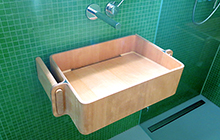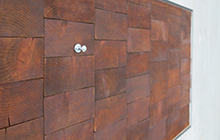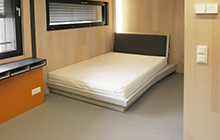Vision Wood
Vision Wood is home to a wealth of timber-based innovations. The unit was developed by the Department of Applied Wood Materials at Empa and in collaboration with ETH Zurich. It combines the latest developments in wood research with expertise in modern wood construction. With one eye on the goal, namely to broaden the range of applications for the renewable resource, the researchers give wood completely new functions and improve the properties of wood-based materials. The Vision Wood housing unit offers two doctoral students a home. As they exchange ideas and experiences with researchers from Empa and ETH Zurich, as well as the industrial partners involved, they test the suitability of the new applications for daily use as residents and users.
Here you find all scientific publications concerning Vision Wood.
Media Articles
Beispielartikel
Downloads
Article Holzrevue 2015 (in German)
The innovation objects in the Vision Wood unit

Binder-reduced wood-fibre
By using natural enzymes, researchers from Empa have succeeded in producing high-quality wood-fiber insulation plates. Thanks to laccase-catalyzed reactions, the synthetic binding agent (styrene butadiene copolymer) can be replaced fully by sustainable, environmentally friendly biopolymers (lignin compounds, modified starch). This method satisfies the demands for sustainability and answers consumer calls for healthy living and energy efficiency.

Surface coating with nanofibrillated cellulose
Nanofibrillated cellulose is used as a component in a novel surface coating for outdoor wood to increase its durability significantly compared to conventional coatings. It is especially expected to improve UV protection, waterproofing, resistance to wear and tear, and the prevention of cracks and microorganism infestations.

Antimicrobial wood surfaces
An enzymatic method patented by Empa enables bacteriostatic iodine in the wood structure to be sequestered without causing any washouts. The result is a wood surface that offers lasting protection from infestations by unwelcome microorganisms and thus increases the hygiene of wooden products significantly in bathrooms or kitchens.
Partner: Empa

Hydrophobic wood
In a two-step process, waterproof monomers on the cell walls of the wood structure are polymerized in situ without damaging the wood lumen. This results in a waterproof property right down to the deeper layers while preserving the look of the untreated wood.
Partners: Empa, ETH Zurich

Magnetic wood
By inserting iron oxide nanoparticles in the wood structure, magnets are able to stick to the wood. Unlike a conventional magnetic material, the hierarchical structure of wood is used to induce direction-dependent magnetic behavior (anisotropy) in the novel hybrid material (wood/metal). As for its application, it is possible to configure wood elements in such a way that they can be directed selectively or reoriented as required when a magnetic field is applied.
Partners: Empa, ETH Zurich

Mineralized Wood
Using the methods developed, it is possible to embed minerals deep inside the wooden structure. Their storage can be controlled and takes place either in the cell walls of the wood or in the cell lumen. As a result, the treated wood achieves greater flame resistance, which makes it just the ticket for use in areas where flame-retardant properties are required.
Partners: Empa, ETH Zurich, Schilliger Holz Industrie AG, Hess & Co AG, Pavatex

Composite bamboo material for decking
A new composite material has been produced using bamboo fibers and a bio-based resin. Similar in strength to steel, the material is extremely robust and, thanks to its weather resistance, just the ticket for use outdoors. Moreover, the material boasts a low gross density and thermal expansion.
Partners: Empa, ETH Future City Lab

Functionalized cellulose in silicone
Nanocellulose fibers are used as thickening agents in sanitary silicone for sealing purposes. Here, the natural nanofibers substitute the conventional, inorganic and poorly degradable thickeners, and improve the mechanical properties of the silicone.
Partners: Empa, Falcone

Sustainable and flame-retardant PU foams
Halogen-free, flame-retardant additives for polyurethane (PU) foams based on sulfur and nitrogen compounds have been produced. This development enables conventional, toxic additives to be replaced while offering the same, if not better, protection for the material. Possible applications are especially envisaged for furniture, such as armchairs, sofas and beds.
Partners: Empa

Beech plywood as a material for modular construction
Beech grows in abundance in Europe’s forests and, despite its high degree of mechanical strength, is barely used in construction. Instead, it is primarily used as fuel. Fagus Jura intends to change this by producing plywood panels made of beech for timber structures. The considerable strength of these panels enables a particularly slender structure in modular timber construction.
Partners: Empa, Fagus Jura, Bundesamt für Umwelt BAFU, Henkel

Decentralized individual room ventilation
A small ventilation unit assigned to the window and integrated in the façade supplies the room in question with fresh air and recovers heat from the exhaust air. As the ventilation function is connected to the window opening and the quality of the air in the room via sensors, the mechanical ventilation only kicks in when it is really needed.
Partners: Ego Kiefer

Combined home and kitchen ventilation
Wesco’s solution has revolutionized domestic ventilation. The ventilator in the kitchen now doubles up as the central extractor for exhaust air in the apartment and regulates the amount of waste air in coordination with the bathroom and WC ventilators, which are also integrated in the system. Fresh air is supplied by a decentralized system installed near the façade, which helps maintain the air balance in the apartment at all times.
Partners: Wesco

Optimized energy efficiency for the perfect indoor climate
To optimize the energy efficiency, the lighting, sunshade, heating, ventilation and air conditioning controls are integrated in a regulator in the room automation. The room controller ecos504 by SAUTER regulates the lighting of the rooms via the DALI interface so that only as much energy is consumed as actually required.
Partners: Sauter


